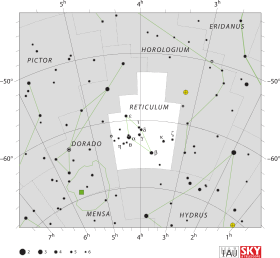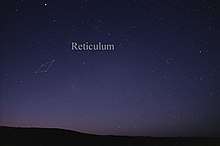Reticulum
Reticulum is a small, faint constellation in the southern sky. Its name is Latin for a small net, or reticle—a net of crosshairs at the focus of a telescope eyepiece that is used to measure star positions.[1] The constellation is best viewed between October and December, but it cannot be seen from middle to northern latitudes.[2]
| Look up reticulum in Wiktionary, the free dictionary. |
| Constellation | |
 | |
| Abbreviation | Ret |
|---|---|
| Genitive | Reticuli |
| Pronunciation | /rɪˈtɪkjʊləm/, genitive /rɪˈtɪkjʊlaɪ/ |
| Symbolism | the Reticle |
| Right ascension | 4h |
| Declination | −60° |
| Quadrant | SQ1 |
| Area | 114 sq. deg. (82nd) |
| Main stars | 4 |
| Bayer/Flamsteed stars | 11 |
| Stars with planets | 7 |
| Stars brighter than 3.00m | none |
| Stars within 10.00 pc (32.62 ly) | none |
| Brightest star | α Ret (3.33m) |
| Messier objects | none |
| Bordering constellations | Horologium Dorado Hydrus |
| Visible at latitudes between +23° and −90°. Best visible at 21:00 (9 p.m.) during the month of January. | |
History
A constellation in this area was introduced by Isaac Habrecht II in his celestial globe in 1621, who named it Rhombus.[3] It was replaced with a somewhat different constellation by the French astronomer Nicolas Louis de Lacaille in the eighteenth century; during his stay at the Cape of Good Hope, he named the constellation le Réticule Rhomboide to commemorate the reticle in his telescope eyepiece.[4] The name was later Latinized to Reticulum in his star catalogue Coelum Australe Stelliferum. In 1810, the stars of Reticulum were used by William Croswell to produce the constellation Marmor Sculptile, which represented the bust of Christopher Columbus, but this did not catch on among astronomers.[5]
The constellation Reticulum became officially recognized during the First General Assembly of the International Astronomical Union in 1922. The boundary for this and other constellations was drawn up by Belgian astronomer Eugène Delporte along arcs of right ascension and declination for epoch 1875. These were published in 1930 in the Delimination Scientifique des Constellations at the behest of the IAU.[6][7]
Features

Only two of the stars in this constellation are brighter than visual magnitude 5: Alpha (α) and Beta (β) reticuli. The reddish star R Reticuli is a Mira variable. This variable was discovered by C. Ragoonatha Chary at the Madras Observatory in India.[8]
The binary star system Epsilon Reticuli consists of a spectral class K2IV star being orbited by a white dwarf. Based on parallax measurements, this system is located about 50 light years from the Sun. In 2000, a planetary companion was announced, orbiting the star ε Reticuli A.[9]
Zeta Reticuli is a wide binary star system, with both members being similar to the Sun. It is located at a distance of about 39 light years. This system gained some notoriety in ufology when the alleged alien abductees Betty and Barney Hill named it as the home of their abductors.
In 2005, a type 1a supernova was discovered in the spiral galaxy NGC 1559, located in the constellation.[10]
The dwarf galaxy Reticulum II is enriched in r-process heavy elements.[11]
The Horologium-Reticulum Supercluster is a galaxy supercluster that ranges from 700 million to 1.2 billion light-years from Earth.
References
- Ridpath, Ian (1989). Star Tales. James Clarke & Co. pp. 10–11. ISBN 0-7188-2695-7.
- Farinacci, Jeff A. (2008). Guide to Observing Deep Sky Objects. Springer. pp. 150–151. ISBN 1-387-72850-4.
- AtlasCoelestis.com: "Jacob Bartsch ― Usus Astronomicus Planisphaerii Stellati Argentoratum (Strasburgo) 1624"
- Ian Ridpath's Star Tales – Reticulum
- Kanas, Nick (2007). Star maps: history, artistry, and cartography. New York, New York: Springer. p. 130. ISBN 0-387-71668-8.
- Kanas (2007:308–309).
- Bradt, Hale (2004). Astronomy methods: a physical approach to astronomical observations. Cambridge University Press. p. 53. ISBN 0-521-53551-4.
- Kameswara Rao, N.; Vagiswari, A.; Thakur, Priya; Birdie, Christina. "C.Ragoonatha Chary and his Variable Stars". arXiv:0908.3081v1 [astro-ph.SR].
- Chauvin, G.; Lagrange, A.-M.; Udry, S.; Mayor, M. (November 2007). "Characterization of the long-period companions of the exoplanet host stars: HD 196885, HD 1237 and HD 27442. VLT/NACO and SINFONI near-infrared, follow-up imaging and spectroscopy". Astronomy and Astrophysics. 475 (2): 723–727. arXiv:0710.5918. Bibcode:2007A&A...475..723C. doi:10.1051/0004-6361:20067046.
- ESO Public Affairs Department. "Celestial Blast in Bleak Reticulum". European Organisation for Astronomical Research in the Southern Hemisphere (ESO). Archived from the original on 2013-02-18. Retrieved 2009-09-05.
- Ji, Alexander P.; Frebel, Anna; Chiti, Anirudh; Simon, Joshua D. (21 March 2016). "R-process enrichment from a single event in an ancient dwarf galaxy". Nature. 531: 610–613. arXiv:1512.01558. Bibcode:2016Natur.531..610J. doi:10.1038/nature17425. PMID 27001693.
External links
| Wikimedia Commons has media related to Reticulum. |
- The Deep Photographic Guide to the Constellations: Reticulum
- The clickable Reticulum
- Starry Night Photography: Reticulum Constellation
- Star Tales – Reticulum